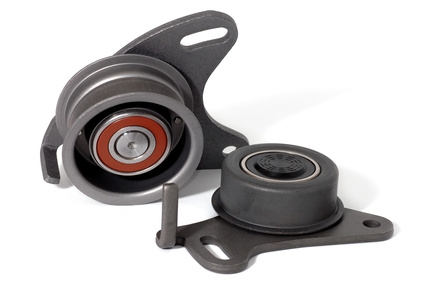
The Ford Taurus has used nearly a dozen different engines since it was introduced in 1985, but every one of them use a serpentine belt arrangement. A serpentine belt is so-called because it "snakes" in and out of the pulleys, using both its front and back surfaces to turn them. all Taurus serpentine belts come off and go on in the same basic way---the only difference is in the belt routing and how you'll get the belt back onto the pulleys.
Locate the belt tensioner. This spring-loaded pulley puts pressure on the belt to keep it on the engine. The tensioner pulley location should be marked on your belt diagram, but on most Tauruses you can find it near the top-center of the engine.
Grip the extended bolt in the center of the tensioner pulley with either a socket or wrench. You should use a socket if you have the room, but there usually won't be. Ford sells specialized tensioner-pulley wrenches for some years of Taurus that are designed to snake into the engine bay and facilitate belt removal, but there's always some way to make a wrench work.
Apply enough pressure to the tensioner bolt that the tensioner begins to rotate. If you have the room, slip a two-foot long piece of pipe over your wrench or ratchet handle to give you the required leverage. The tensioner pulley will rotate clockwise on some engines and counterclockwise on others. If your belt diagram doesn't specify, then crank the tensioner so that it rotates toward the crankshaft pulley.
Slip the belt off of the tensioner and the pulley adjacent to it. Release the tensioner and pull the belt out of the engine.
Install the new belt according to your belt diagram, starting with the pulleys at the lower-rear of your engine and working toward the front and top. Installing the belt this way will help to reduce the time you'll spend spitting, cursing and digging through your engine bay to slip the belt back onto a buried pulley. You may need to install the belt on your tensioner pulley before the front-most pulley if you don't have enough clearance between the tensioner and wheel-well to get the belt onto the tensioner afterward. But, in general, you'll want to save the tensioner pulley for last.
Rotate the tensioner pulley back toward the engine and slide the belt over it, making sure that it is perfectly centered on the tensioner pulley and seated into the grooves on every other pulley.
Get in the car and turn the ignition key to the start position for about half a second and release. Give the engine five or six quick bumps like this without starting it, then get out and inspect the belt to make sure that it's still properly seated on the pulleys.